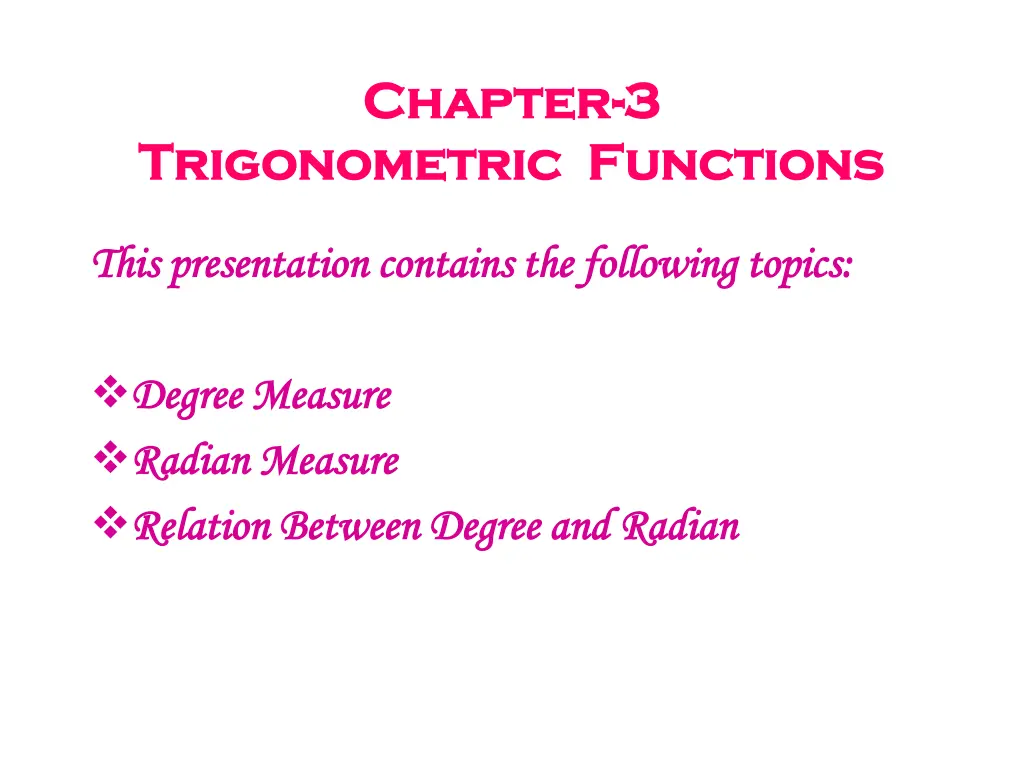
Understanding Trigonometric Functions and Angle Measurement
Explore the concepts of degree and radian measures, relation between degrees and radians, and the basics of trigonometric functions. Learn how angles are measured and the significance of radians in mathematics.
Download Presentation

Please find below an Image/Link to download the presentation.
The content on the website is provided AS IS for your information and personal use only. It may not be sold, licensed, or shared on other websites without obtaining consent from the author. If you encounter any issues during the download, it is possible that the publisher has removed the file from their server.
You are allowed to download the files provided on this website for personal or commercial use, subject to the condition that they are used lawfully. All files are the property of their respective owners.
The content on the website is provided AS IS for your information and personal use only. It may not be sold, licensed, or shared on other websites without obtaining consent from the author.
E N D
Presentation Transcript
Chapter Chapter- -3 3 Trigonometric Functions Trigonometric Functions This presentation contains the following topics: This presentation contains the following topics: Degree Measure Degree Measure Radian Measure Radian Measure Relation Between Degree and Radian Relation Between Degree and Radian
Angles and Its Measurement Angle : An angle is made up of C two rays with a common end point. This point is B A called the vertex of the angle, and the rays are called sides of the angle. Signs of Angles : - The above definition is useful in geometry . But in trigonometry, we need broader definition of an angle . Let a rotating ray starting from OX, rotate about O in a plane and stop at OP . Then it is called the angle XOP. OX is called initial side, OP is called terminal side and O is the vertex , of the angle. If rotation is anticlockwise, the angle is positive, if the rotation is clockwise, the angle is negative.
Measuring Angles : - The measure of an angle is the amount of rotation made to get the terminal side from its initial side. There are several units for measuring angles. These are i. Degree Measure ii. Radian Measure Degree Measure : - In this system an angle is measured in degrees, minutes, and seconds. If a rotation from initial side to terminal side is (1/360)thof a revolution, the angle is said to have a measure of one degree. Which is written as 10. A degree is further subdivided as : 1 degree = 60 minutes , written as 10= 60 and 1 minute = 60 seconds, written as 1 = 60
Radian Measure :- In this system the angle is measured in radian. A radian is an angle subscribed at the center of the circle by an arc whose length is equal to the radius of the circle. Or , Angle subtended at the center by an arc of length I unit in a unit circle ( circle of radius 1 unit) is said to have a measure of 1 radian. In the fig angle AOB is 1 radian . The radian measure and the real numbers are considered as one and the same. A B O
Relation Between Radian and Degree Measure Since a circle subtends at the center an angle whose radian measure is 2 and its degree measure is 3600 . Therefor , we have a relation 2 radian = 3600 => radian = 1800 => 1 radian = 1800 / also 10 = / 180 the relation between degree measure and radian measure of some common angles is given bellow: Degree 300 450 600 900 1350 1800 3600 Radian /6 /4 /3 /2 3 /4 2
Length of an arc of a Circle : -If an arc of length I subtend an angle radian at the center of a circle of radius r , then Note :since l and r have same units , the ratio l/r has no units. Hence l/r is a real number and it implies that is a real number. Trigonometric Functions In class 10th we have studied trigonometric ratios for acute angles as the ratio of sides of a right triangle. Now we study them as a trigonometric function. Consider a unit circle with center at origin of the coordinate axes. Let P(a,b) be any point on the circle with angle AOP = x radian . From triangle OAM we have cos x = a and sin x = b . = l/r or l = r.
as we know that one revolution = 2 radian => AOB = /2, AOC = , AOD = 3 /2 . All the angles which are integral multiples of /2 are called quadrantal angles . The coordinates of the points A, B, C and D are (1 ,0) , (0, 1), (-1 ,0) and (0 , -1). Therefor , for quadrantal anles we have cos 00 = 1 cos /2 = 0 cos = -1 cos 3 /2 = 0 cos 2 = 1 we can say that sin x is 0 at all integral multiples of and cos x is 0 at all odd multiples of /2 . sin 00 = 0 sin /2 = 1 sin = 0 sin 3 /2 = -1 sin 2 = 0
Sign of Trigonometric Functions:- According to the coordintes of the point P( a,b) , the signs of all trigonometric functions are different in all four quadrants. Which shows in the table : I quad. II quad. III quad. IV quad. Positive Positive Negative Negative sin x Positive Negative Negative Positive cos x Positive Negative Positive Negative tan x Positive Positive Negative Negative cosec x Positive Negative Negative Positive sec x Positive Negative Positive Negative cot x
Trigonometric Functions of Sum and Difference 1. sin(-x) = - sin x , for all x R 2. cos(-x) = cos x , for all x R 3. cos (x + y ) = cos x cos y sin x sin y 4. cos (x y) = cos x cos y + sin x sin y 5. sin (x + y ) = sin x cos y + cos x sin y 6. sin (x y) = sin x cos y cos x sin y 7. tan (x + y ) = (tan x + tan y )/ (1- tanx . tan y) 8. tan (x y) = (tan x tan y )/(1 + tan x. tan y) 9. cot (x + y) = (cot x. cot y 1)/ (cot x + cot y) 10.cos 2x = cos2x sin2 x = 2 cos2 x -1 = 1 2 sin2 x 11.sin 2x = 2 sin x . cos x = (2 tan x)/(1 + tan2 x)
12. tan 2x = (2 tan x)/(1 tan2 x) 13. sin 3x = 3 sin x 4 sin3 x 14. cos 3x = 4 cos3 x 3 cos x 15. tan 3x = (3 tan x tan3 x)/(1 3 tan2 x) 16. cos x + cos y = 2 cos (x + y)/2. cos (x y)/2 17. cos x cos y = - 2 sin (x + y)/2 . sin (x - y)/2 18. sin x + sin y = 2 sin(x + y)/2 . cos(x y)/2 19. sin x sin y = 2 cos(x +y)/2 . sin(x y)/2 20. 2cos x cos y = cos(x + y) + cos (x y) 21. 2sin x sin y = cos(x y) cos (x + y)






















